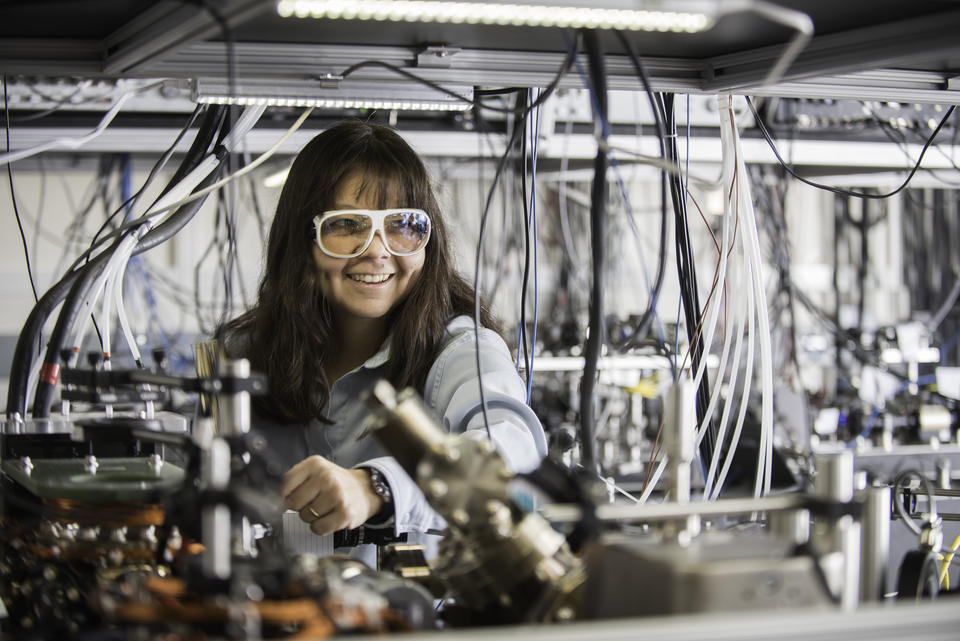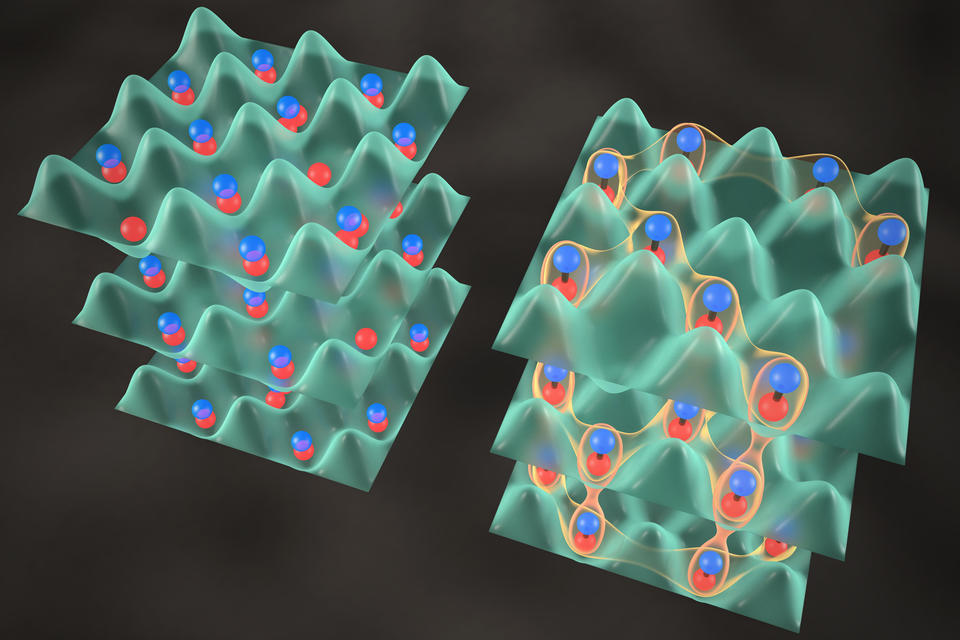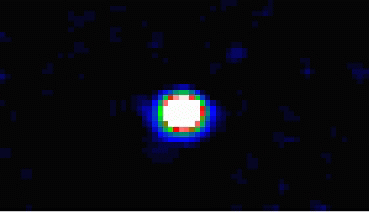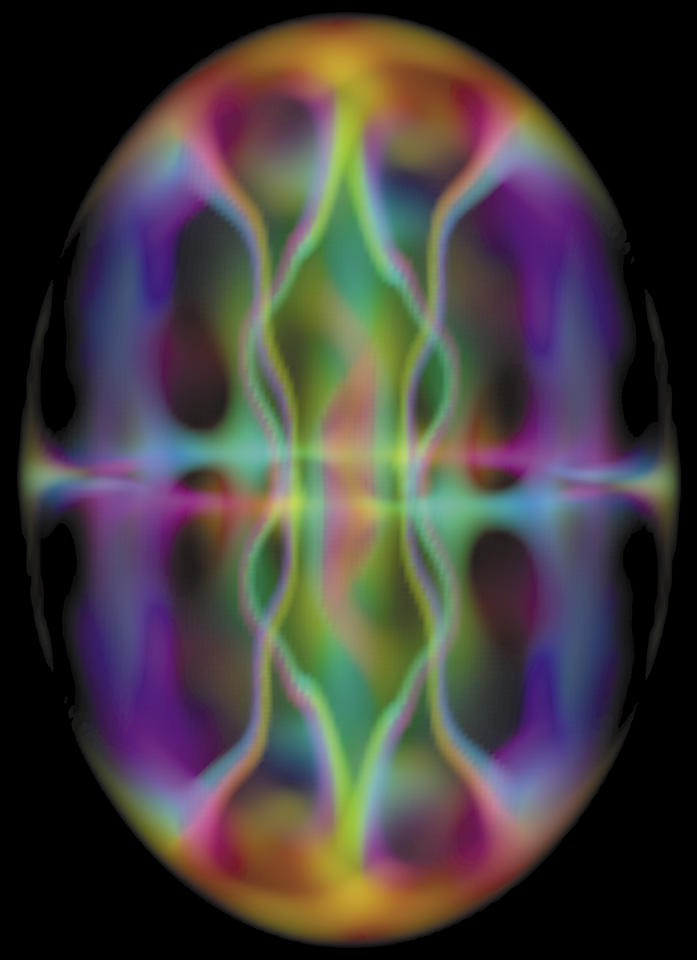The Prize’s Legacy: Eric Cornell
When Cornell announced his group’s achievement of BEC to colleagues at a conference in Capri, Italy, later in June 1995, audience members stood up and cheered, according to Steve Rolston, then a researcher in Bill Phillips’ lab and now co-director of the NIST-University of Maryland Joint Quantum Institute (JQI).
“It’s the only standing ovation I’ve ever seen at a physics meeting,” he says.
Just months after Cornell’s and Carl Wieman’s discovery, Wolfgang Ketterle’s group at MIT created a Bose-Einstein condensate of roughly 500,000 sodium atoms. It was visible to the naked eye and had enough atoms in it that Ketterle was able to separate the condensate into two parts that he then got to interact with each other.
Researchers later made Bose-Einstein condensates from potassium, lithium, cesium and helium atoms. In 1998, after 20 years of trying, MIT researchers finally coaxed hydrogen into a BEC, earning yet another conference standing ovation. By the time Cornell, Wieman and Ketterle accepted their Nobel Prizes six years later, 35 groups around the world were producing Bose-Einstein condensates and publishing papers roughly every two days. By the 10th anniversary of BEC’s discovery, it was 100 groups, and the field continues to grow.
Eric Cornell and Carl Wieman not only created Bose-Einstein condensate; they made it attainable to physicists around the world. Making BECs, once considered so challenging many thought it would be impossible, has become routine, a fact that has enabled an explosion in the kinds of research being done on them.
Although variations on the original combination of laser and magnetic trapping are still common, scientists can now create BECs by laser cooling alone. In 2009, German researchers succeeded in creating Bose-Einstein condensates out of strontium and calcium, atoms with quantum properties that make them particularly good candidates for use as gravity detectors or navigation aids, among other possible applications.
In 2003, the late Deborah Jin, a JILA fellow and former postdoctoral researcher with Cornell’s group, created the first fermionic condensate out of potassium atoms. Fermions—the half of the particle family tree not occupied by bosons—refuse to collapse in a single quantum wave like BEC-creating bosons. Rather, their electrons pair up in ways familiar to condensed-matter physicists working on superconductivity. The possibility of using a fermion condensate to study superconductivity—the flow of electricity without resistance—has drawn many condensed-matter physicists into ultracold gas research.

Bose-Einstein condensates are now key players in the growing field of ultracold gases, which includes BECs, fermionic condensates and molecular condensates. In 2008, the groups of Jun Ye and Deborah Jin used optical frequency combs and other technologies to create an ultracold molecular gas combining a potassium fermion and a rubidium boson.

While research into the creation of BECs itself continues, BECs are increasingly used as tools of science.
“Perhaps the most surprising thing about BEC was what a rich platform it’s been for studying other physics,” says Rolston. At JQI alone, he says, eight different groups now make BECs in their labs. This dual role is common for scientific discoveries, which are valuable not only for their own sake but also for enabling new fields of study and often unanticipated advances.
“When lasers were first invented, people spent a lot of time studying lasers,” Cornell said in an interview with the Boulder Daily Camera. “There are still people who study lasers, but most use them for something else.”
Cornell has used BECs to study superfluidity (fluids that flow with zero friction) in the simplified form presented in a BEC. He has created quantum vortices in BECs, and has used them to better understand what drives the Casimir-Polder force, a weak electromagnetic effect that causes surfaces to attract atoms. He and Wieman also compressed a BEC to the point it exploded into what they called a “Bosenova.”

Cornell also has created very thin sheets of BECs that could act like thin films of high-temperature superconductors that scientists are trying to create. Atoms moving through them would behave like electrical current and help scientists both understand and better know how to create these highly desirable materials, which would conduct electricity with no resistance. Cornell also has studied what happens when cold atoms get very close together, so they are in a “quasi-condensate” state somewhere between a liquid and a typical BEC.

Cornell suffered a major setback in late 2004, when he was struck with necrotizing fasciitis, a tissue-destroying disease. He narrowly survived with an amputated left arm, and has had to adapt to life without his left arm and shoulder. The recovery process was difficult, but by 2006 Cornell was back at work full time.
A particularly active area in BEC studies is the use of BECs suspended in webs of light known as optical lattices. In this setup, the atoms in BECs would act as “bits” (the carriers of 0s and 1s) in prototype quantum computers, which could solve certain problems much faster than ordinary computers, and in quantum simulators, which could help physicists understand complex materials such as high-temperature superconductors. NIST Fellow Bill Phillips and his JQI colleagues are among the scientists leading such efforts.
BECs have yet to be commercialized, but companies are exploring whether they could form the basis for instruments that measure quantities such as magnetism, gravity and acceleration with unprecedented accuracy. They could lead to aircraft or missile navigation systems resistant to jamming and, in theory, millions of times more accurate than today’s standard.
In addition, Cornell and several other researchers are preparing experiments for an atomic physics lab roughly half the size of a dishwasher, scheduled to be launched to the International Space Station in 2017. The lab will be operated by astronauts, with commands sent to the space station by Cornell and others. Cornell hopes to take advantage of the zero-gravity environment in space to cool a BEC to the coldest temperature scientists have yet to achieve.
For Cornell, such breadth of possibility adds weight to advice he has long given his students.
“Pay attention to the physics going on around you. Go to the department colloquium even if it’s not your thing,” Cornell says. “One of the keys to success is making connections to things maybe others haven’t seen.”
“Eric’s a really good public citizen, in terms of both the scientific community at large, and also especially within JILA, doing a lot of the work you need to do to get people working together... He’s a very good speaker and writer… Eric is really outstanding [at communicating to people].”
– Carl Wieman, professor of physics and education at Stanford University, previously Eric Cornell’s postdoctoral advisor and colleague at JILA
Additional Sources
The Cornell Group Website. JILA (University of Colorado Boulder/NIST). Web. https://jila.colorado.edu/cornell-group
E.A. Cornell – Biographical. Nobelprize.org. Nobel Media AB 2014. Web. http://www.nobelprize.org/nobel_prizes/physics/laureates/2001/cornell-bio.html
E.A. Cornell - Nobel Lecture: Bose-Einstein Condensation in a Dilute Gas; The First 70 Years and Some Recent Experiments. Nobelprize.org. Nobel Media AB 2014. Web. http://www.nobelprize.org/nobel_prizes/physics/laureates/2001/cornell-lecture.html

